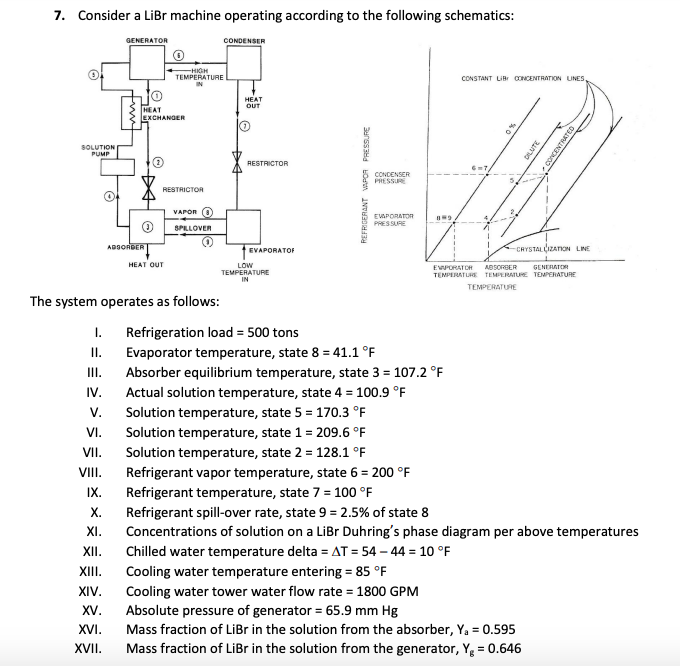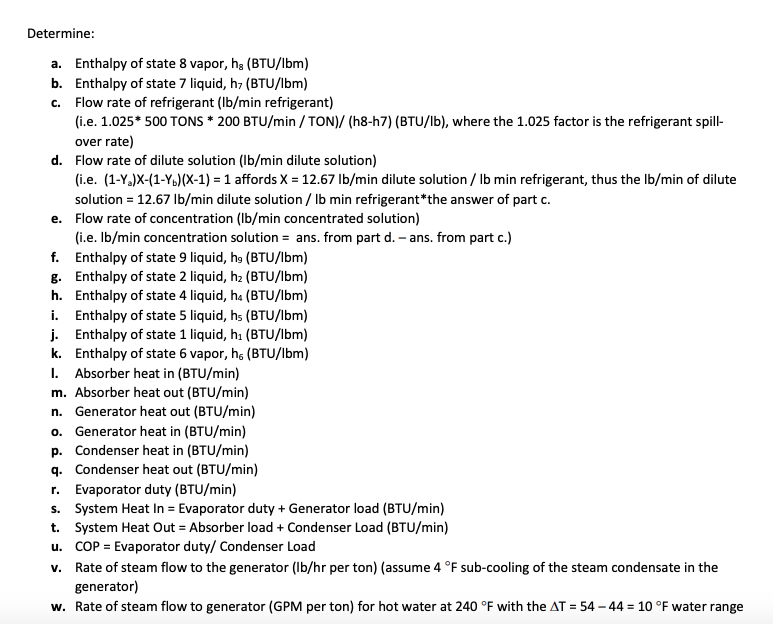7. Consider a LiBr machine operating according to the following schematics: GENERATOR CONDENSER TEMPERATURE CONSTANT LI CCENTRATION UNES, HEAT OUT NEAT EXCHANGER SOLUTION PUMP RESTRICTOR CONCENSER PRESSURE RESTRICTOR VAPOR EAPORATOR PRESSRE SPLLOVER EVAPORATO CRYSTAL CZanoN LNE LOW TEMPERATURE HEAT OUT EWORATOR AeSoRER GLNERA TEMPERATUE TEMERATUE TEMPERATURE TEMPERATURE he system operates as follows: 1. Refrigeration load = 500 tons II. Evaporator temperature, state 8 = 41.1 °F II. Absorber equilibrium temperature, state 3 = 107.2 °F IV. Actual solution temperature, state 4 = 100.9 °F V. Solution temperature, state 5 = 170.3 °F %3D VI. Solution temperature, state 1 = 209.6 °F %3D VII. Solution temperature, state 2 = 128.1 °F Refrigerant vapor temperature, state 6 = 200 °F Refrigerant temperature, state 7 = 100 °F Refrigerant spill-over rate, state 9 = 2.5% of state 8 Concentrations of solution on a LiBr Duhring's phase diagram per above temperatures XII. Cooling water temperature entering = 85 °F VII. IX. X. XI. Chilled water temperature delta = AT = 54 – 44 = 10 °F XIII. XIV. Cooling water tower water flow rate = 1800 GPM Absolute pressure of generator = 65.9 mm Hg Mass fraction of LiBr in the solution from the absorber, Y, = 0.595 XV. XVI. XVII. Mass fraction of LiBr in the solution from the generator, Y, = 0.646 REFRGERANT VAPON PHESSURE
7. Consider a LiBr machine operating according to the following schematics: GENERATOR CONDENSER TEMPERATURE CONSTANT LI CCENTRATION UNES, HEAT OUT NEAT EXCHANGER SOLUTION PUMP RESTRICTOR CONCENSER PRESSURE RESTRICTOR VAPOR EAPORATOR PRESSRE SPLLOVER EVAPORATO CRYSTAL CZanoN LNE LOW TEMPERATURE HEAT OUT EWORATOR AeSoRER GLNERA TEMPERATUE TEMERATUE TEMPERATURE TEMPERATURE he system operates as follows: 1. Refrigeration load = 500 tons II. Evaporator temperature, state 8 = 41.1 °F II. Absorber equilibrium temperature, state 3 = 107.2 °F IV. Actual solution temperature, state 4 = 100.9 °F V. Solution temperature, state 5 = 170.3 °F %3D VI. Solution temperature, state 1 = 209.6 °F %3D VII. Solution temperature, state 2 = 128.1 °F Refrigerant vapor temperature, state 6 = 200 °F Refrigerant temperature, state 7 = 100 °F Refrigerant spill-over rate, state 9 = 2.5% of state 8 Concentrations of solution on a LiBr Duhring's phase diagram per above temperatures XII. Cooling water temperature entering = 85 °F VII. IX. X. XI. Chilled water temperature delta = AT = 54 – 44 = 10 °F XIII. XIV. Cooling water tower water flow rate = 1800 GPM Absolute pressure of generator = 65.9 mm Hg Mass fraction of LiBr in the solution from the absorber, Y, = 0.595 XV. XVI. XVII. Mass fraction of LiBr in the solution from the generator, Y, = 0.646 REFRGERANT VAPON PHESSURE
Elements Of Electromagnetics
7th Edition
ISBN:9780190698614
Author:Sadiku, Matthew N. O.
Publisher:Sadiku, Matthew N. O.
ChapterMA: Math Assessment
Section: Chapter Questions
Problem 1.1MA
Related questions
Question
solve d, e , f and g only

Transcribed Image Text:7. Consider a LiBr machine operating according to the following schematics:
GENERATOR
CONDENSER
-HIGH
TEMPERATURE
CONSTANT LIBr CONCENTRATION UNES.
HEAT
OUT
HEAT
EXCHANGER
SOLUTION
PUMP
RESTRICTOR
CONDENSER
PRESSURE
RESTRICTOR
VAPÓN
EVAPORATOR
PRESSURE
SPILLOVER
ADsORDER
EVAPORATOF
-CRYSTALLIZATON LINE
HEAT OUT
LOW
TEMPERATURE
IN
EVORATOR ABSORBER
TEMPERATLRS TEMPERATURE TEMPERATURE
GENERATOR
TEMPERATURE
The system operates as follows:
I.
Refrigeration load = 500 tons
Evaporator temperature, state 8 = 41.1 °F
Absorber equilibrium temperature, state 3 = 107.2 °F
Actual solution temperature, state 4 = 100.9 °F
I.
III.
IV.
V.
Solution temperature, state 5 = 170.3 °F
VI.
Solution temperature, state 1 = 209.6 °F
VII.
Solution temperature, state 2 = 128.1 °F
VIII.
Refrigerant vapor temperature, state 6 = 200 °F
IX.
Refrigerant temperature, state 7 = 100 °F
X.
Refrigerant spill-over rate, state 9 = 2.5% of state 8
Concentrations of solution on a LiBr Duhring's phase diagram per above temperatures
XI.
XII.
Chilled water temperature delta = AT = 54 – 44 = 10 °F
XIII.
Cooling water temperature entering = 85 °F
XIV.
Cooling water tower water flow rate = 1800 GPM
Absolute pressure of generator = 65.9 mm Hg
XV.
XVI.
Mass fraction of LiBr in the solution from the absorber, Y. = 0.595
XVII.
Mass fraction of LiBr in the solution from the generator, Yg = 0.646
CONCENTRATED

Transcribed Image Text:Determine:
a. Enthalpy of state 8 vapor, ha (BTU/lbm)
b. Enthalpy of state 7 liquid, h, (BTU/lbm)
c. Flow rate of refrigerant (Ib/min refrigerant)
(i.e. 1.025* 500 TONS * 200 BTU/min / TON)/ (h8-h7) (BTU/lb), where the 1.025 factor is the refrigerant spil-
over rate)
d. Flow rate of dilute solution (Ib/min dilute solution)
(i.e. (1-Y,)X-(1-Y,)(X-1) = 1 affords X = 12.67 Ib/min dilute solution / Ib min refrigerant, thus the Ib/min of dilute
solution = 12.67 Ib/min dilute solution / Ib min refrigerant*the answer of part c.
e. Flow rate of concentration (Ib/min concentrated solution)
(i.e. Ib/min concentration solution = ans. from part d. – ans. from part c.)
f. Enthalpy of state 9 liquid, he (BTU/lbm)
g. Enthalpy of state 2 liquid, h2 (BTU/lbm)
h. Enthalpy of state 4 liquid, ha (BTU/lbm)
i. Enthalpy of state 5 liquid, hs (BTU/lbm)
j. Enthalpy of state 1 liquid, h, (BTU/lbm)
k. Enthalpy of state 6 vapor, h, (BTU/Ibm)
I. Absorber heat in (BTU/min)
m. Absorber heat out (BTU/min)
n. Generator heat out (BTU/min)
o. Generator heat in (BTU/min)
p. Condenser heat in (BTU/min)
q. Condenser heat out (BTU/min)
r. Evaporator duty (BTU/min)
s. System Heat In = Evaporator duty + Generator load (BTU/min)
t. System Heat Out = Absorber load + Condenser Load (BTU/min)
u. COP = Evaporator duty/ Condenser Load
v. Rate of steam flow to the generator (Ib/hr per ton) (assume 4 °F sub-cooling of the steam condensate in the
generator)
w. Rate of steam flow to generator (GPM per ton) for hot water at 240 °F with the AT = 54 – 44 = 10 °F water range
Expert Solution
This question has been solved!
Explore an expertly crafted, step-by-step solution for a thorough understanding of key concepts.
Step by step
Solved in 4 steps with 3 images

Knowledge Booster
Learn more about
Need a deep-dive on the concept behind this application? Look no further. Learn more about this topic, mechanical-engineering and related others by exploring similar questions and additional content below.Recommended textbooks for you

Elements Of Electromagnetics
Mechanical Engineering
ISBN:
9780190698614
Author:
Sadiku, Matthew N. O.
Publisher:
Oxford University Press

Mechanics of Materials (10th Edition)
Mechanical Engineering
ISBN:
9780134319650
Author:
Russell C. Hibbeler
Publisher:
PEARSON

Thermodynamics: An Engineering Approach
Mechanical Engineering
ISBN:
9781259822674
Author:
Yunus A. Cengel Dr., Michael A. Boles
Publisher:
McGraw-Hill Education

Elements Of Electromagnetics
Mechanical Engineering
ISBN:
9780190698614
Author:
Sadiku, Matthew N. O.
Publisher:
Oxford University Press

Mechanics of Materials (10th Edition)
Mechanical Engineering
ISBN:
9780134319650
Author:
Russell C. Hibbeler
Publisher:
PEARSON

Thermodynamics: An Engineering Approach
Mechanical Engineering
ISBN:
9781259822674
Author:
Yunus A. Cengel Dr., Michael A. Boles
Publisher:
McGraw-Hill Education

Control Systems Engineering
Mechanical Engineering
ISBN:
9781118170519
Author:
Norman S. Nise
Publisher:
WILEY

Mechanics of Materials (MindTap Course List)
Mechanical Engineering
ISBN:
9781337093347
Author:
Barry J. Goodno, James M. Gere
Publisher:
Cengage Learning

Engineering Mechanics: Statics
Mechanical Engineering
ISBN:
9781118807330
Author:
James L. Meriam, L. G. Kraige, J. N. Bolton
Publisher:
WILEY